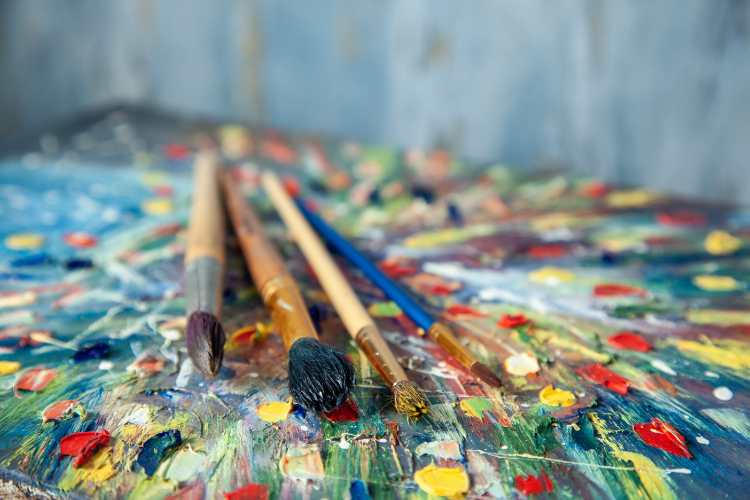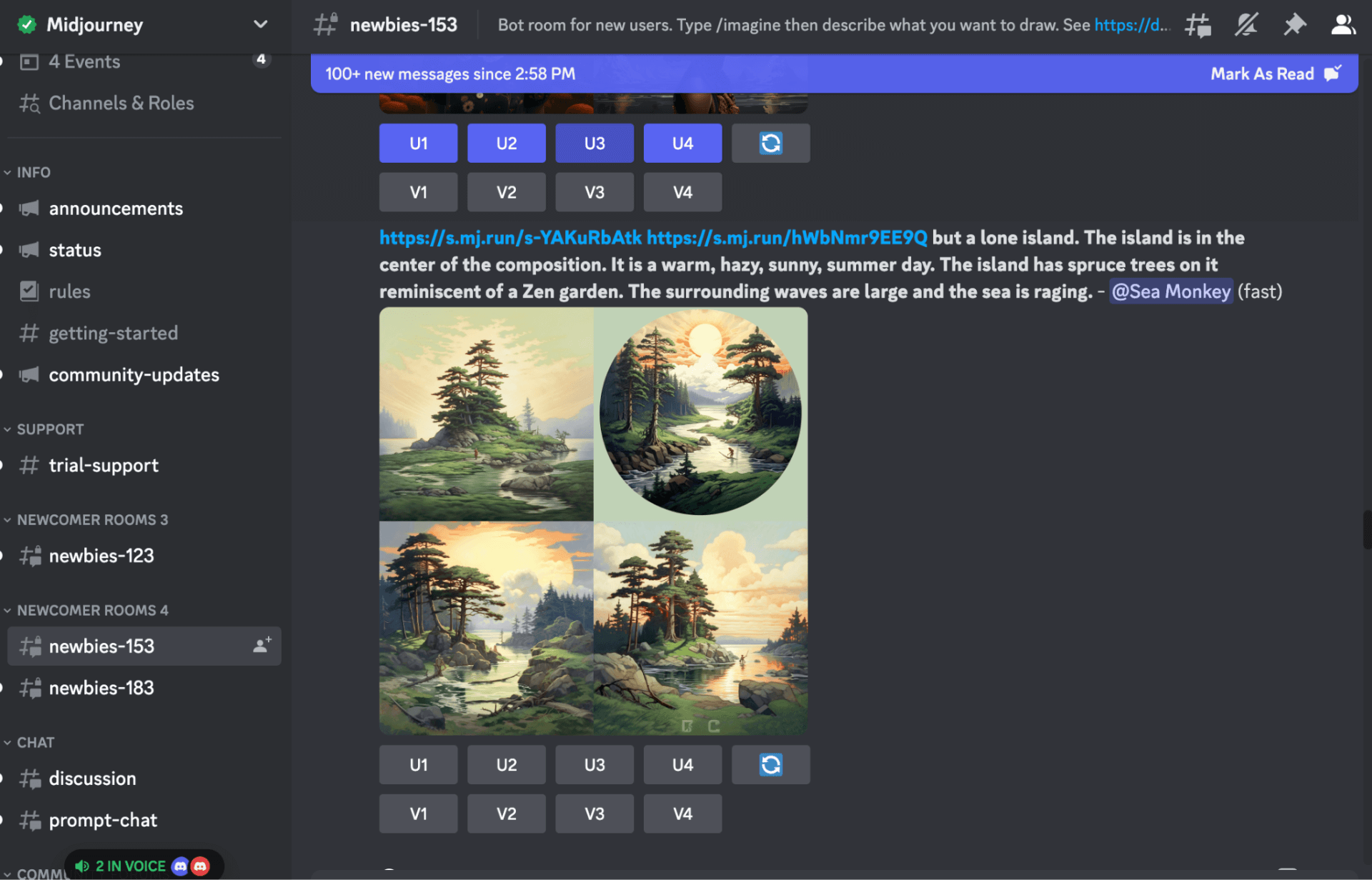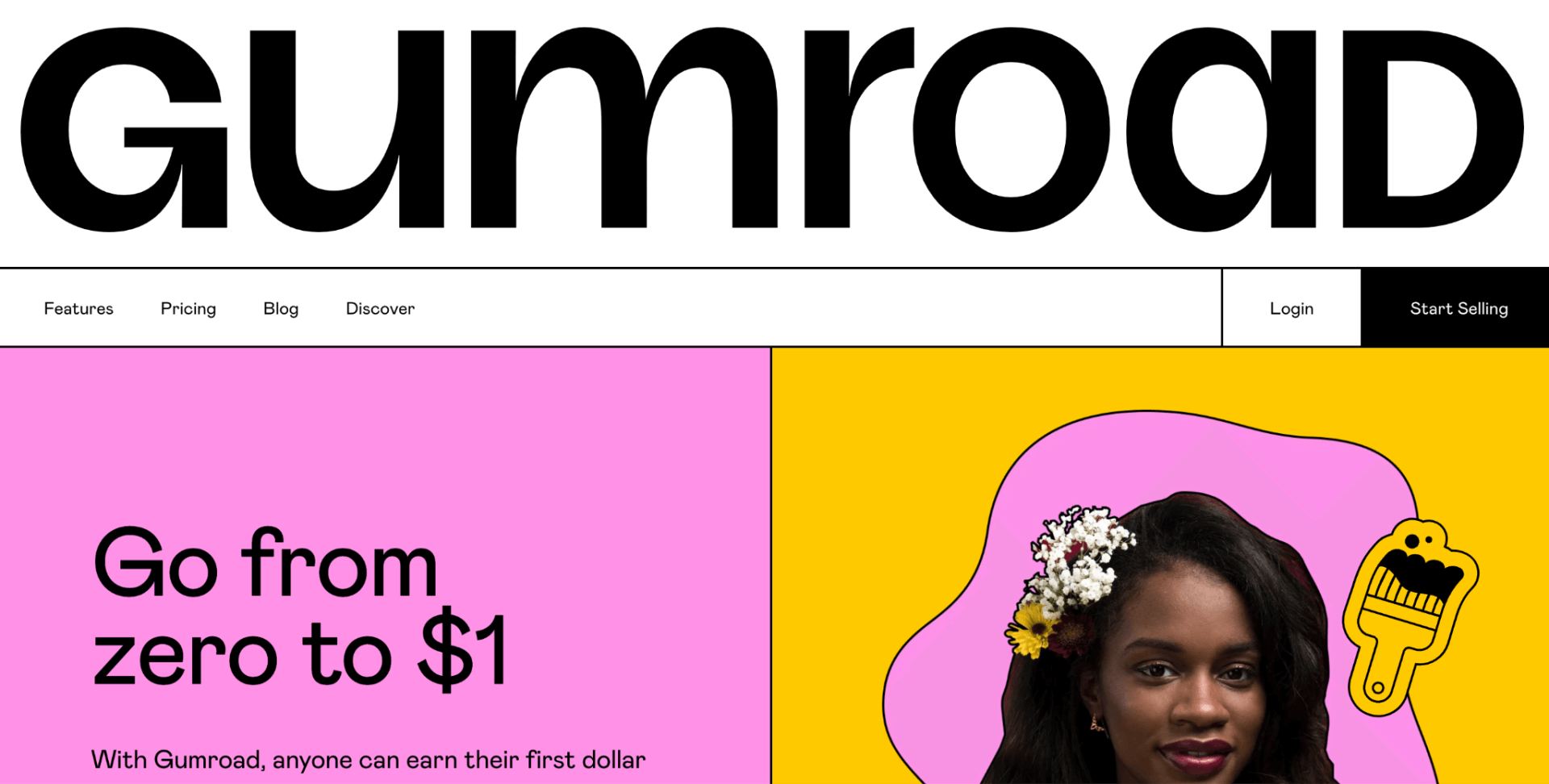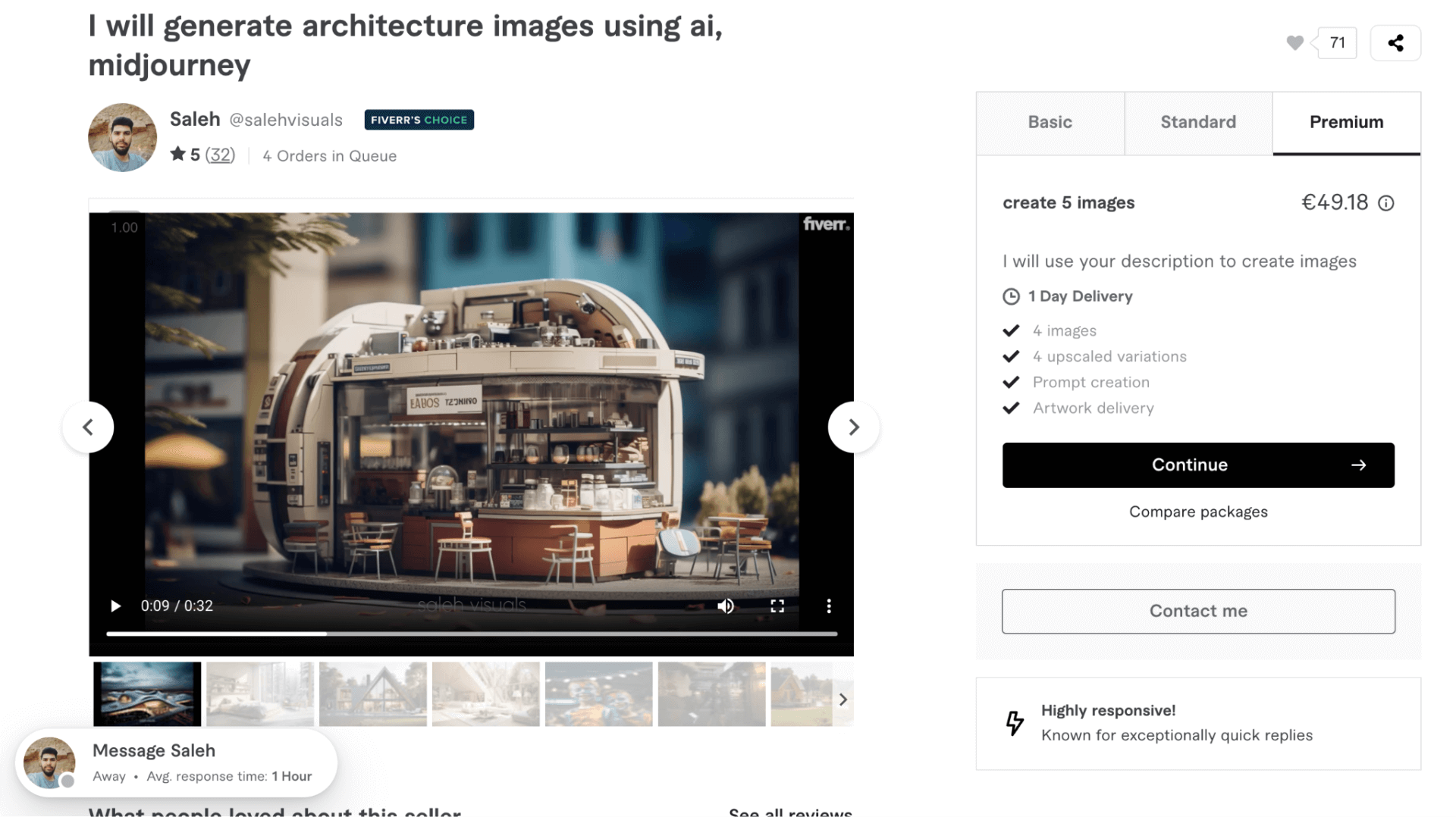How to Use AI Art to Make Money

Right now is the best time to use AI art to make money.

In fact, over the past 12 months, the search trend for the keyword ‘make money with AI art’ has sparked many people to jump on board.
As a result, don’t blame me if you miss out on one of the easiest money-making methods of the last few years.
While this is not a promise of passive income (since you still have to do some work), we live in a time where your skill level no longer limits you.
Making money with AI art relies on two equally important pieces:
- first is generating high-quality images
- second is knowing how to use this art to make money.
In this article, I’ll give you my take on both pieces so you can jump on this opportunity to strike while it’s still hot.
Creating High-Quality Images
If you’re trying to sell junk in any marketplace, you’ll have a hard time. The same applies to AI images.
A few months ago, this was the case with most of the AI art created. If it involved anything human-related, the output generally included extra limbs, fingers, and sometimes heads.

Image credit: https://www.buzzfeednews.com/
It was quite funny…if you didn’t plan on selling such art (for those who can call it that).
However, over the last few months, the quality has improved a hundred times over. With the right tools and prompts, you can now create high-quality images. Sometimes, it’s hard to distinguish AI-generated images from human-created ones.
AI Art Generators
The tool you use to create your art plays a significant role in the final output. Here are the top three tools I recommend based on my own personal experience:
- DALL-E 2 (now part of ChatGPT)
- Midjourney
- Jasper
Here’s a quick rundown of these tools.
DALL-E 2 (Integrated With ChatGPT)

Having a DallE membership used to be separate from having a ChatGPT account. However, with a ChatGPT Plus membership, you now get DallE integrated within the same interface.
Moreover, after a November 2023 update, you can prompt the AI tool with plain English commands and DallE will kick in. Before, you had to go through a few extra clicks to get to the right menu.
Why should you consider using DallE?
DALL-E is great for creating surreal pieces that push the boundaries of imagination. You can edit and manipulate images to your liking.
Since there are no set templates, users have reported finding it tough to create photorealistic images or portraits of people. This is partly due to the fact that the output quality relies on a specific prompt in English (more on how to get around this below).
Users also report the application tends to generate a higher proportion of images of men than women for prompts that do not mention gender.
Midjourney

Midjourney is another tool that can output some incredible AI art. Accessing this tool requires you to go into their Discord channel and type in your command. Without more advanced configurations, others can see your inputs and outputs.
The quality of the images you can create in Midjourney is quite mind-blowing:
Here are the pros and cons of Midjourney:
Pros
- Its ability to match specific styles and refine images until satisfied has undoubtedly set it apart from other art platforms.
- The output closely reflects the given prompt, requiring little modification.
- Subscription plans start from as low as $10 per month.
Cons
- Midjourney is only available through a Discord server.
- Customer service is not the platform’s strong suit.
- Since everyone gets to see others’ images, it’s easier to have copyright issues.
- While there are plans for the tool to move away from Discord, this hasn’t happened at the time of writing.
- Subscription plans can get as high as $120 on the Mega Plan (here the focus is on ‘fast jobs’)
Jasper Art

Another tool that has improved significantly over the last few months is Jasper. What I love about this tool is that there are specific templates you can use when creating AI images.
These templates include:
- Food photography
- Ink art
- News graphic
- Product closeups
- Realistic animals
- Realistic person
- Stock photography
- Storybook illustration
- Travel photography
As you create your art, you have the choice to attach your own images and let the platform model them to create AI generated art.
Using the Right Prompt
When it comes to prompting AI, I believe the more detailed you are with your instructions, the better the final output. However, I also believe that at some point, there are diminishing returns.
Trying to come up with the perfect prompt can often lead to frustration. It’s much better to start with something manageable and then refine your input after each step.
Also, know that the same prompt will (probably) give you different outputs each time you run it, so there’s little point in trying to get that perfect prompt.
For example, here’s a detailed prompt:
A photograph of an attractive woman, freshly awakened taking a home-made style selfie. The woman looks into the camera with sleepy yet hopeful eyes. The background is a cosy bedroom with white linens. Soft, dawn lights filters through sheer curtains, casting a golden glow on her face. Type of photograph: selfie, taken on: samsung galaxy s21. camera settings: f/1.8, iso 80, 1/50 sec.
Using DallE (within ChatGPT), here’s the output I get:

Let’s run the command again in a new ChatGPT window (using the same DallE model). Same platform, same model. This is what I now get:

Similar but different…this is what I mean by the perfect prompt doesn’t exist.
Refining your Prompt
Let’s take another example. I’m going with:
a coffee cup with a coffee foam 3d figure of a cute duck soaking its head while its tail is showing/wagging.
Not super detailed / as detailed as the above. Here’s the output:

Not the most inspirational cute duck. Let’s refine this:
A coffee cup featuring an intricate 3D foam art of a cute duck, skillfully crafted from marshmallow. The duck is playfully designed, appearing as if it’s soaking its head in the coffee while its tail wags above the foam. The coffee cup is placed on a rustic wooden table, capturing the cozy ambiance of a coffee shop in the background. The shop has warm, soft lighting, creating a welcoming and homely atmosphere. Include fine details on the coffee figure, emphasizing the artistry of the foam art. The image should convey a warm aesthetic, focusing on the coffee cup as a product portrait, with the background softly blurred to keep the main focus on the detailed coffee art.
Here’s the output:

How do you create better image prompts? A big question with quite a straightforward answer. Let’s ask ChatGPT itself.
Here’s an example of a very basic prompt and the corresponding output:

I then asked ChatGPT how I could make the image better. Here’s the answer:
To enhance and refine your image prompt for creating a more detailed and vivid representation of a dystopian industrial city, consider these elements:
- Architectural Details: Specify the types of buildings and structures. For instance, you could describe the architectural styles, whether they’re old, rusting factories or futuristic, high-tech industrial complexes.
- Environmental Elements: Elaborate on the environmental conditions. This could include details like acid rain, rivers polluted with industrial waste, or patches of dead vegetation.
- Atmospheric Conditions: Provide more details about the sky and air quality. You might mention specific colors or effects in the sky, like a red haze, perpetual smog, or swirling ash.
- Lighting and Time of Day: Describe the lighting conditions. Is it an eternally overcast day, a murky twilight, or a night scene lit by the harsh glow of factory lights?
- Human Element (Optional): If you want to include a human aspect, consider describing the inhabitants or the lack thereof. You could mention figures in protective gear, crowds of workers, or the absence of human life to emphasize desolation.
- Street Level Details: Include descriptions of the ground level. Are there abandoned vehicles, littered streets, or overgrown railway tracks?
- Mood and Atmosphere: Reinforce the mood you want to convey. Words like ‘oppressive’, ‘forbidding’, ‘desolate’, or ‘chaotic’ can guide the overall feel of the image.
- Color Palette: Suggest a color scheme. For a dystopian city, you might want muted, dark colors, or stark contrasts between industrial structures and their surroundings.
The next step? Asking ChatGPT to create a new prompt based on the above factors.

Here’s the updated prompt:
Create a highly detailed and realistic painting of a dystopian industrial city at twilight. The cityscape is dominated by a mix of towering, rust-covered factories and futuristic, high-tech industrial complexes. The air is thick with a swirling mix of smog and ash, under a sky tinged with a sinister red haze, reflecting the city’s relentless industrial activity. Streets are illuminated by the harsh, artificial glow of neon lights from the factories, casting long shadows and highlighting the desolation. The ground level is a scene of neglect, with abandoned vehicles, litter-strewn streets, and overgrown railway tracks. Despite the advanced industrial setup, there’s a notable absence of human life, emphasizing an eerie, ghost-town atmosphere. The buildings themselves are a stark contrast of old and new, some crumbling under their own decay while others stand sleek and imposing. The overall mood is oppressive and forbidding, captured in a color palette of muted darks, rust oranges, and cold metallic hues, creating a striking visual of a city lost to its own industrial might.
Let’s run this and see what DallE manages to generate:

Here’s another example starting from this basic prompt:
Create an image of a 32-year-old guy riding his Honda Hornet motorcycle on a relaxing Sunday ride next to the sea. The sun is out, life is good and the world is peaceful.
That’s how I like to imagine myself on a Sunday morning…
Here’s the initial output:

I love the picture. However, where’s the riding gear? As a rider, that’s one of the first questions that comes to mind. Let’s see if ChatGPT can address this in the list of improved factors to use in the next prompt.
Here are the first three ‘improvement factors’:
- Rider’s Appearance and Attire: Describe the rider’s clothing and physical features. Mention details like a leather jacket, helmet design, or casual attire to set the mood of a leisurely ride.
- Motorcycle Details: Provide specifics about the motorcycle, like its color, design features, or any custom modifications that make it stand out.
- Surrounding Landscape: Elaborate on the coastal landscape. Include details like sandy beaches, rugged cliffs, or a lively boardwalk with people enjoying the day.
Awesome. I’ll now ask ChatGPT to create a better prompt. This is the result:
Create an image of a 32-year-old man with a relaxed and joyful demeanor, riding his vibrant red Honda Hornet motorcycle on a scenic coastal road. It’s a beautiful Sunday, and the golden sunlight of late afternoon bathes the scene in a warm, inviting glow. The rider is dressed in casual yet stylish protective gear, featuring a sleek black leather jacket and a unique, custom-designed helmet. The road is a picturesque, winding path that hugs the coastline, offering stunning views of the sparkling sea to one side and lush greenery to the other. A gentle sea breeze carries the fresh scent of saltwater. In the background, the beach is lively with people enjoying the day, and a few boats are visible on the horizon. Seabirds are soaring in the sky, adding to the sense of freedom and tranquility. The rider’s posture is one of contentment and ease, capturing the essence of a perfect, peaceful day out on the open road, with the world feeling harmonious and serene around him.
Based on the updated prompt, this is the result:

I think this is much more realistic. Also, nice touch with the golden hour!
At the end of the day, it’s about:
- Creating a detailed prompt
- Refining it until it suits your needs
Download the Image
If you’re using an AI image tool that offers multiple formats for download, go with the highest resolution possible. It’s easier to monetize your images when working with better-quality images.
This is an example from Jasper Art:

If I wanted to monetize this image, I’d go for the 2048×2048 resolution. Higher numbers mean high image quality.
Upscale your Image
If you need higher resolutions than those AI tools offer, you’ll need to use an image upscaler. These are useful in cases where the image needs to be made larger without losing quality.
For example, if you want to sell AI images for use in:
- Posters
- Wallpapers
- Billboards
then you’d likely need to upscale the image to a bigger size. Just consider that larger images will take more time and resources to process.
Also, remember that upscaling is not magic, so you should only go as high as necessary. Doing too much can cause unwanted artifacts in your image and it won’t look its best.
Here’s a YouTube video that reviews some of the top AI image upscalers along with their capabilities and pricing models:
AI Image Monetization
Now, let’s talk about making money. I’ll first talk about quick wins you can get from an AI art generator, then, I’ll dive into a long-term strategy you can consider after you’ve found your initial success.
Quick Wins
Want to start making money today? Here are some ideas you can implement now to get started.
Marketplaces
There are plenty of marketplaces where you can put up AI images for sale. The following are my top three suggestions.
Etsy

Etsy is a global online marketplace formerly known for various handmade products. For those interested in selling AI images, Etsy now provides a great platform.
It supports sellers with low fees, robust tools, and educational resources. Etsy also ensures a secure shopping and selling experience. The platform offers a safe environment for both buyers and sellers.
Here’s how to set up and sell on Etsy:
Redbubble

Redbubble connects over 700,000 artists and designers with millions of enthusiasts worldwide. The platform operates on a Print-On-Demand (POD) model.
Artists open a free shop on Redbubble, upload their designs, and choose products to feature their AI generated artwork. When a customer buys a product, Redbubble prints and ships the design on the item.
How do artists make money?
Artists earn a royalty on the purchase price. Royalties are paid monthly via PayPal or bank transfer once they reach a $20 threshold.
Here’s more information on how to sell on Redbubble:
Gumroad

Gumroad simplifies the process of selling by providing an easy checkout system.
Apart from selling tools, Gumroad offers marketing tools to track sales and build customer loyalty programs. With features like Gumroad Discover for increased visibility, tags for search optimization, and affiliate marketing opportunities, there’s lots to explore on this platform.
At the end of 2022, Gumroad increased its pricing structure. While I won’t get into whether this is good or bad, keep in mind that there are pros and cons to using such marketplaces.
Also, whatever marketplace you intend on using, knowing the pricing structure (i.e., how much money will end up in your pocket) is important.
Here’s all you need to know about selling on Gumroad:
Commercial Licensing
Note: licensing AI images is still a gray area. Depending on who you speak to, you might get a different opinion regarding who the image owner is. I’m not a lawyer. I advise you to consult with one if you intend to go this route.
So, what is commercial licensing? If you can generate high-quality images in in-demand niches, you can also license them for commercial use on sites like Adobe Stock and others.
The process works as follows. First, you generate the images—and potentially upscale them based on a site’s policies.
Secondly, you upload the images to a site and fill in the necessary details.
Next, you wait. That’s all there is.
Once people search for images that match your descriptions and keywords, your artwork will start popping up. Then some people will pay money to use these images for commercial purposes. The image sites then pay you a royalty.
Sites that currently accept AI-generated images include:
Most sites also allow different image formats. These could include illustrations, vectors, infographics, digital paintings, etc. Knowing the formats that sites accept allows you to refine your AI image prompt to create the desired outputs.
Creating Your Own Services/Products Using AI Images
While you have to play by others’ rules when using the above methods, you’re in control when creating your own products or services. Here’s what this could look like.
Creating AI Art as a Freelancer
Using platforms like Fiverr, you can create custom packages related to AI image creation.
For example, a quick search on the platform for AI image generation gave the following:

One seller named Saleh offers architecture-based images generated using Midjourney. He offers different packages based on the number of images wanted.

I found instances of similar gigs on Upwork. Here’s one example:

Creating Print-on-Demand Products
If the idea of
- uploading AI images online
- placing them on physical items (like t-shirts, bags, hoodies, etc.)
- marketing them
- and getting a commission when someone orders
appeals to you, this might be for you.
With this method, you can sell physical items without getting into the fulfillment and delivery logistics.
Platforms like Teespring and Teepublic allow you to do just that. These platforms provide product creation and selling tools to make life easier. Here’s a quick start guide for Teespring if you want more information.
Also, check out the Crafty Design case study later on where I share a real example of a business using this method.
Designing Greeting Cards and Invitations for Local Markets
Want to go after a less saturated market while still maximizing the power of AI? Going local might be key.
For example, could you design, market, and sell:
- greeting cards
- birthday cards
- wedding invitations
- or holiday cards?
If you match any of these niched cards with the right target audience, you might be onto a winning idea.
To succeed with this idea, you must research the market you’re going after and see what already exists. Then, consider what’s missing in the market or how to differentiate your products.
If you can learn to use graphic design software to make minor modifications to your AI outputs, you could offer highly customized versions of your cards.
You could even use AI and machine learning to design more complex cards. While this goes beyond the scope of this article, you could look into creating greeting cards with 3D images or incorporating special effects into your cards.
Developing Adult Drawing Books
For some reason, I still find the concept of adult coloring books strange. Maybe it’s because I never really got into it as a child.
However, there’s a big market for this niche. A quick look at Amazon proves this: 90,000 results.

From an SEO point of view, the keyword ‘adult coloring book’ is also searched for 3.8 thousand times monthly. Even better, it has a low keyword difficulty:

If I were to get into this business, I would focus on one specific niche. Here are a few examples from Amazon search results:

On a single row, you can see coloring books about:
- Flowers
- Patterns
- Tiny Worlds
- Fantasy
So how do you go about creating these adult coloring books? It depends on the platform you use.
Jasper has a specific template that can help with this. It’s called ink art. Here’s what I managed to generate with this very basic prompt:
A person working on his laptop in a coffee shop. This will be used in an adult coloring book so only provide the outline.
Output:

Here’s a more detailed prompt:
A detailed black and white outline suitable for an adult coloring book, depicting a scene in a coffee shop. The central figure is a man of South Asian descent, sitting at a table, deeply focused on his laptop. Around him, the coffee shop is bustling with activity—baristas preparing drinks, customers chatting, and the cozy ambiance of the shop with its stylish decor.
And here’s Jasper’s output after using this prompt (using the freeform template—the ink art template started throwing errors when I tried this more detailed prompt):

Not too bad, not too great. Here’s a closeup of one of the images:

Here’s what I got when using the same prompt in DallE (through ChatGPT):

I think that’s an insane level of detail and possibly an output you could use without much modification.
Let’s say that you have your adult coloring book niche selected. You then generate all the images you want to use.
What next?
Amazon KDP might be the easiest way to monetize your work. You can upload your book, fill in the relevant details, and have it available for purchase within a couple of hours.
Here’s a complete tutorial on how to do so:
Considering The Long Term
Let’s say you use the above methods and find success. You make money with AI digital art and document the process you’ve gone through.
At some point, you decide you want a long-term plan to make money with this technology. That’s when you start looking into an online course platform that can help you share your success with others.
Here, the aim will be to teach them the stuff you learned along the way (both the good and the bad) so they can replicate the same success themselves.
While I don’t have the space to get into creating a long-term strategy in this article, I just wanted to point this out. There’s a difference between short-term tactics and long-term strategy.
Knowing which stage you’re in (and how to move to the next one) is key to business success.
AdamEnfroy.com started as a blog where Adam wrote all his blog posts. Over time, he started seeing success and teaching others his steps. Eventually, this led to BlogGrowthEngine.com. In this course, he goes in detail about what it takes to run a successful blogging business that makes money.
According to statistics, courses allow you to earn anywhere between $5000-$120000 per year.
Moreover, AI courses will be really lucrative, really soon. Definitely something to consider as AI becomes more integrated into everyday life.
Here’s more information on how to start an online course for beginners:
Crafty Design Case Study
Here’s a real-life example that shows you how one artist has combined AI to align with her expertise.
Matylda Micallef’s journey with Crafty Designs is an excellent example of what happens when the human mind meets AI technology and creates something exceptional.
Crafty Designs offers an online store with designs “focused on the very fragile yet powerful human mind and its connection with body and soul”.

The Use of AI Tools and Software
Matylda starts her creative process with ideas from her journal or ideas inspired by books. She then uses AI image tools to turn these concepts into initial images.
But she doesn’t stop there.
She says she uses Adobe Fresco to enhance these AI-generated images. This is where her personal touch comes in—she adds unique styles and details to make each design truly hers.

In other words, AI gives her a starting point, and then she adds her magic to it.
Matylda’s artistic skills are crucial in transforming these basic images into artworks that tell a story. It’s a partnership where the machine offers efficiency, and the human adds soul and depth.
Further Human and Machine Collaboration
Matylda also uses AI writing software to help with her product descriptions. Using a mix of generated text and her own hand-crafted words, Matylda can produce compelling product descriptions. These descriptions end up being both meaningful and informative.
The Idea Behind the Brand
Crafty Designs is more than just a brand. As a business that reflects Matylda’s personal journey, her designs are visual stories about the mind, body, and soul. They are also based on her experiences and those around her.
Her art is meant to spark conversations about mental health and personal growth.

Each piece has its own story to tell, making it more than just a design on a t-shirt or a bag.

Profitability and Success
Matylda uses platforms like Teespring and Teepublic to sell her designs. These platforms handle the logistics regarding printing and shipping. They also let her focus on creating art.

In terms of monetization, Crafty Designs is still in its early stages. So far, Matylda’s main investment has been her time and effort in making art and building the brand.
When pricing her products, she takes into account two main factors:
- the physical item itself
- her commitment to ensuring her designs are accessible to my audience
She aims to strike a delicate balance between accessibility and her art’s value.
At the same time, success for Matylda isn’t just about making money. It’s about touching lives and starting conversations about important topics like mental health. Her goal is to create art that connects with people on a deeper level.
What can you take away from Crafty Designs? For me, it’s all about using AI to enhance the creative process and finding ways to bridge the gap between art, technology, and accessibility.
It’s also about realizing that your own personal touch is something that no artificial intelligence or algorithm can replicate. That’s why it’s important to always strive for quality, no matter what medium you use to express yourself.
Conclusion
Making money with AI art requires you to understand what YOU bring to the table.
In an age where everyone can produce image art by typing in a prompt and refining it, I believe your unique creative touch will make the difference.
Once you establish this, you can use the above methods to profit from your AI art.
As you do, always have a long-term view in mind. AI art has a lot of potential and will only improve in the future.
Consider what you can do now to establish yourself as an AI artist. Doing so will help you capitalize on the opportunities that come your way.





